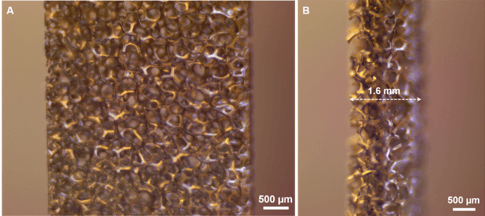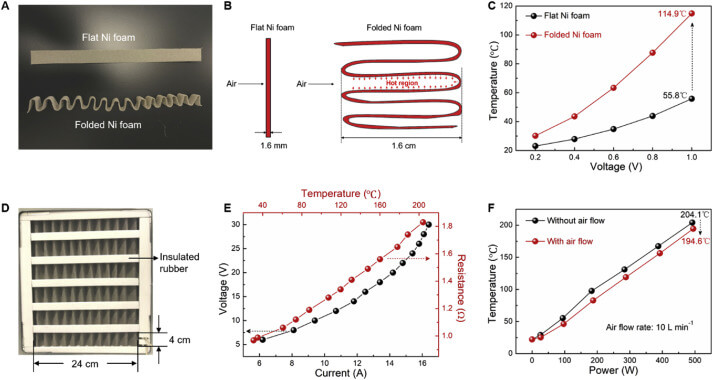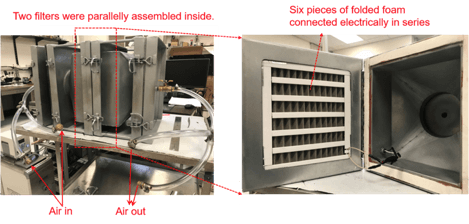Device for virus experiment. Photographs show the device details (left) and one of the two filters using folded Ni foam (right).
On December 31, 2019, Wuhan Municipal Health Commission, China, reported a cluster of cases of pneumonia in Wuhan, Hubei Province. On Jan 5, 2020, WHO published the first disease outbreak news (titled Pneumonia of unknown cause – China) on the new virus, and gradually a novel coronavirus was eventually identified. After then on 11 March 2020, WHO made the assessment that COVID-19- the disease caused by coronavirus, can be characterized as a pandemic when there were 6,526 confirmed cases around the globe with 2,037 daily increasing cases. Update on 5:01pm CEST, 18 July 2020, globally there have been 13,876,441 confirmed cases of COVID-19, including 593,087 deaths. Noone exactly when will this upward going numbers stops. Everyone can do is pray the numbers to stop and follow the standard guidelines issued by health institutions, for now.
To curb coronavirus from our society and also to buy time for government officials to prepare for the probable upcoming devastating situations, different appropriate approaches like complete/partial lockdown of states/countries were employed, face masks and coverings being compulsory, and closing of market places where there is a chance of gathering many peoples.
Though appropriate limiting methods were employed and even exist globally, we all are in a dire need of a vaccine/antidote that can cure COVID-19 and so the world can return back to its normal condition.
In the race to search for the vaccine/antidote of COVID-19, biotech companies and other concerned companies/organizations/institutions are working on their respective ways. Some are heading to design drugs that can hinder coronavirus from entering the host cell whereas some are working on designing different diagnostic tools like a face mask that can light up when it detects coronavirus.
Somehow similar to the lightening face mask, a team of researchers from the University of Houston has designed an air filter that can catch and kill the coronavirus - the virus responsible for COVID-19.
The research project was accomplished with a collaboration between Zhifeng Ren, director of the Texas Center for Superconductivity at UH, Monzer Hourani, CEO of Medistar, a Houston-based medical real estate development firm, including other researchers.
The research design was published in the journal Materials Today Physics on 7 July 2020.
“This filter could be useful in airports and in airplanes, in office buildings, schools, and cruise ships to stop the spread of COVID-19,” said Ren, MD Anderson Chair Professor of Physics at UH and the co-corresponding author for the paper. “Its ability to help control the spread of the virus could be very useful for society.” Medistar executives are also proposing a desk-top model, capable of purifying the air in an office worker’s immediate surroundings, he said.
Severe acute respiratory syndrome coronavirus-2 or SARS-CoV-2 transmit through the air and any air-conditioning systems pose a significant threat for the continued escalation of the current coronavirus disease (COVID-19) pandemic. So, the whole world is in an urgent need of a mechanical system that can somehow catch and kill coronavirus together with the medical drug that can cure the host cell. As all can understand, designing a drug for new viruses like coronavirus is tough and it will also have to go through many certified steps which marked it as a prolonged process. Hence, any means that can control the spread in air-conditioned spaces is urgent. Accordingly, the researcher’s team from the University of Houston designed an air filter system depending on and considering that SARS-CoV-2 will not tolerate a temperature above 70 °C or about 158 °F. They did not only maintained the air filter’s temperature to just above 70 °C but about at 200 °C and were able to kill the virus almost instantly.
The team designed and fabricated efficient filters based on heated nickel (Ni) foam to catch and kill SARS-CoV-2 and they also tested their design.
The virus test results revealed that 99.8% of the aerosolized SARS-CoV-2 was caught and killed by a single pass through a novel Ni-foam–based filter when heated up to 200 °C.
Here they used Nickel (Ni) foam as Ni met several required characteristics like porous, electrically conductive, and flexible.
The design also requires a low temperature of air after it passes through the heated Ni foam that means the outgoing air must have a low temperature; if the air temperature becomes too high, the heated Ni foam would not be suitable for large-scale application. By testing this with blowing the high-purity nitrogen (N2) gas towards one side of the heated Ni foam and measuring the air temperature at the different opposite sides, they found that the room temperature was about 21.7 °C which indicates that the Ni foam can be best for this use and give us wide applications. They observed that even for the Ni foam with a high temperature of 115.3 °C, the air temperature at 4 cm away was close to just room temperature.

But the Ni has low resistivity so we can not just use a single piece of Ni foam as a filter that satisfies both the size requirement for heating, ventilation and air-conditioning (HVAC) systems and the U.S. residential voltage requirement (110 V). The team solved this by using an idea of a folding mechanism. As the Ni is flexible, they designed a folded structure, connecting multiple compartments with electrical wires which successfully exhibit much larger resistance due to its significantly increased length. Finally, by increasing the resistivity, they were able to raise the temperature as high as 250 °C.

“This novel biodefense indoor air protection technology offers the first-in-line prevention against environmentally mediated transmission of airborne SARS-CoV-2 and will be on the forefront of technologies available to combat the current pandemic and any future airborne biothreats in indoor environments," Dr. Faisal Cheema of UH College of Medicine and co-first author on the papers said.
The team also used the same filter to catch and kill Bacillus anthracis and observed the filter killed 99.9% of Bacillus anthracis.
This study, without doubt, paves the way for preventing transmission of SARS-CoV-2 and other highly infectious airborne agents in closed environments, however, more improvements and also rapid industrialization are required in the near future.
